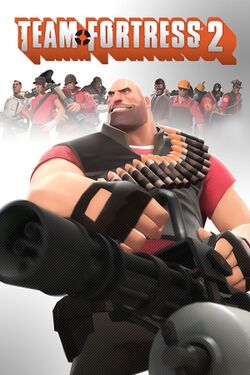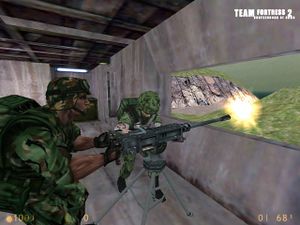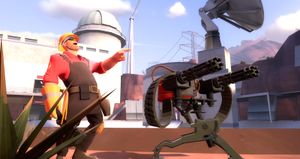Difference between revisions of "Team Fortress 2"
(Undo edit by LeMansRacer (Talk) (577805) Please do not add this again.) |
m (Protected "Team Fortress 2": Counter-productive edit warring ([edit=sysop] (expires 00:34, 1 July 2011 (UTC)) [move=sysop] (expires 00:34, 1 July 2011 (UTC)))) |
(No difference)
| |
Revision as of 00:34, 24 June 2011
| Team Fortress 2 | |
|---|---|

| |
| Basic Information | |
| Released: |
|
| Developer: | |
| Publisher: | |
| Distributor: |
EA Distribution/Steam |
| Engine: | |
| Genre: |
First-person shooter |
| Modes: |
Multiplayer |
| Designer(s): |
John Cook, Robin Walker |
| Ratings: |
|
| Platforms: |
Windows, Xbox 360, PlayStation 3, Mac |
| Media: |
Download, DVD, Blu-ray disc |
| Requirements: |
|
Team Fortress 2 is a multiplayer, team-based, first-person shooter, developed by Valve Corporation as part of the game compilation The Orange Box. It was released for Microsoft Windows, Xbox 360, PlayStation 3 in 2007, and released later as stand-alone retail in 2008.
The game was announced in 1998 as a sequel to the original Team Fortress mod for Quake, but has since been through various concepts and designs. In 1999, the game appeared to be deviating from the original Team Fortress and Valve's own Team Fortress Classic mod for Half-Life by heading toward a more realistic and militaristic style of gameplay, but the design metamorphosed further over the game's nine-year development and game engine switch. The final rendition of Team Fortress 2 bears more resemblance to the original Team Fortress and Team Fortress Classic games, and sports a cartoon-like visual style, based on the art of Dean Cornwell, J. C. Leyendecker and Norman Rockwell, following a popular trend in recent CGI films (in particular, films recently made by Pixar/Disney, such as The Incredibles).
The lack of information or apparent progress for six years of the game's development caused it to be labeled as vaporware, and it was regularly featured in Wired News annual vaporware list among other ignominies. The game has received critical acclaim and several awards since its release.
Contents
Gameplay
Like its predecessors, Team Fortress 2 is built around two opposing teams competing for an objective. These two teams are meant to represent a demolition and a construction company: Reliable Excavation Demolition (RED) and Builders League United (BLU). Players can choose to play as one of nine classes in these teams, each with their own unique strengths and weaknesses. Although the abilities of a number of classes have changed from earlier Team Fortress incarnations, the basic elements of each class have remained.
Team Fortress 2 is the first of Valve software's multiplayer games to incorporate detailed statistics for players. These statistics include the time spent playing as each class, average point score and the most captures or objectives achieved in a single round. (See Valve statistics.) Persistent statistics tell the player how they are improving in relation to these statistics, such as if a player comes close to their record for the damage inflicted in a round. Team Fortress 2 also features numerous achievements for carrying out certain tasks, such as scoring a certain number of kills or completing a round within a certain time. New sets of class-specific achievements have been added in subsequent updates, which add new abilities and weapons to each class once unlocked by the player. Achievements unlocked and statistics from previously played games are displayed on the player's Steam Community or Xbox live profile page.
Maps
On the PC version, the game ships with a number of official maps released by Valve along with several community developed maps. On the console version, however, there are six maps, all released by Valve. The official maps are commonly themed with an evil genius mentality, with secret bases being concealed within industrial warehouses and exaggerated super weapons such as laser cannons and missile launch facilities taking the role of objectives.
When players join a map for the first time, an introductory video shows how to complete map objectives. Map player limits are 24 on the PC, although the player limit has been altered on some servers to reach as high as 32, and 16 on the Xbox 360 and PlayStation 3.
Development
Origins
Originally planned as a free mod for Quake, development on Team Fortress 2 switched to the GoldSrc engine in 1998 after the development team Team Fortress Software - consisting of Robin Walker and John Cook - were first contracted and finally outright employed by Valve corporation. The name of the game was Valve's Team Fortress at this moment. At the point of Team Fortress Software's acquisition production moved up a notch and the game was promoted to a standalone, retail product to tide fans over since, as well as time issues, much of the Team Fortress player base had purchased Half-Life solely in anticipation of the free release of Team Fortress 2. Work began on a simple port of the game which was released in 1999 as the free Team Fortress Classic. Notably, Team Fortress Classic was built entirely within the publicly available Half-Life Software Development Kit as an example to the community and industry of its flexibility.
Walker and Cook had been heavily influenced by their three-month contractual stint at Valve, and now they were working full-time on their design, which was undergoing rapid metamorphosis. Team Fortress 2 was to be a modern war game, with a command hierarchy including a commander with a bird's-eye view of the battlefield, parachute drops over enemy territory, networked voice communication and numerous other innovations.
E3 1999
The new design was revealed to the public at the 1999 Electronic Entertainment Expo (E3), where it earned several awards including Best Online Game and Best Action Game. By this time Team Fortress 2 had gained a new subtitle, Brotherhood of Arms, and the results of Walker and Cook working at Valve were becoming clear. Several new and at the time unprecedented technologies on show: Parametric animation seamlessly blended animations for smoother, more life-like movement, and Intel's Multi-resolution mesh technology dynamically reduced the detail of on-screen elements as they became more distant to improve performance (a technique made obsolete by decreasing memory costs; today games use a technique known as level of detail, which uses more memory but less processing power). No release date was given at the exposition.
In mid-2000, Valve announced that development of Team Fortress 2 had been delayed for a second time. They put the news down to development switching to an in-house, proprietary engine that is today known as the Source engine. It was at around this time that all news ran dry and Team Fortress 2 entered its notorious six-year radio silence, which was to last until July 13, 2006. During that time, both Walker and Cook worked on various other Valve projects—Walker was project lead on Half-Life 2: Episode One and Cook became a Steam developer, among other tasks—raising doubts that Team Fortress 2 was really the active project that would be repeatedly described.
"Invasion" design

When the Half-Life 2 source tree was leaked in late 2003, two Team Fortress 2 models were included, along with direct references to the game in the source code. They consisted of an alien grunt and a very stylized, out-of-proportion human soldier. The code was interpreted by fans as making references to the Seven Hour War, an integral part of the Half-Life story; however, the two leaked player models did not resemble any known style from the Half-Life series.
The Source SDK was released with the Half-Life 2 source code, and also provided references to Team Fortress 2. Some code merely confirmed what was already believed, but other segments provided completely new information, such as the presence of NPCs in multiplayer matches, the possibility of the game taking place in the Half-Life 2 universe, fixed plasma gun and missile launcher emplacements, and more.
None of the leaked information appears to have had any bearing on today's version of the game. This iteration was mentioned in an August 2007 interview with Gabe Newell by GameTrailers and a September 2010 interview with PC Gamer, in which he mentions "Invasion" as being the second phase of Team Fortress 2's development under Valve Software.
Final design
The next significant public development occurred in the run up to Half-Life 2's 2004 release: Valve's Director of Marketing Doug Lombardi claimed that Team Fortress 2 was still in development and that information concerning it would come after Half-Life 2's release. This did not happen; nor was any news released after Lombardi's similar claim during an early interview regarding Half-Life 2: Episode One. Near the time of Episode One's release Gabe Newell again claimed that news on Team Fortress 2 would be forthcoming— and this time it was. Team Fortress 2 was re-unveiled a month later at the July 2006 EA Summer Showcase event.
Walker revealed in March 2007 that Valve had quietly built "probably three to four different games" before settling on their final design. Due to the game's lengthy development cycle it was often mentioned alongside Duke Nukem Forever, another long-anticipated game that has seen many years of protracted development and engine changes.
The beta release of the game featured six multiplayer maps, of which three contain optional commentary by the developers on the game design, level design and character design, and provide more information on the history behind the development.
Team Fortress 2 does not attempt the realistic graphical approach used in other Valve games on the Source engine such as Half-Life 2, Day of Defeat: Source and Counter-Strike: Source. Rather, it uses a more stylized, cartoon-like approach "heavily influenced by early 20th century commercial illustrations.". The effect is achieved using a special Valve in-house rendering and lighting technique making extensive use of 'Phong shading'. The development commentary in the game suggests that part of the reason for the cartoonish style was the difficulty in explaining the maps and characters in realistic terms. The removal of an emphasis on realistic settings allows these questions to be sidestepped. The game debuts with the Source engine's new dynamic lighting, shadowing and soft particle technologies, among many other unannounced features, alongside Half-Life 2: Episode Two. Team Fortress 2 was also the first game to implement the Source engine's new Facial animation 3 features.
The art style for the game was inspired by J. C. Leyendecker, as well as Dean Cornwell and Norman Rockwell. Their distinctive styles of strong silhouettes and shading to draw attention to specific details were adapted in order to make the models distinct, with a focus on making the characters' team, class and current weapon easily identifiable. Silhouettes and animation are used to make the class of a character apparent even at range, and a color scheme that draws attention to the chest area brings focus to the selected weapon.
Maps are designed with a neutral space between two bases. They are archetypal spy fortresses, but disguised as inconspicuous buildings to give plausibility to their close proximities. The maps have little visual clutter and stylized, almost impressionistic modeling, to allow enemies to be spotted more easily. The impressionistic design approach also affects textures, which are based on photos that are filtered and improved by hand, giving them a tactile quality and giving Team Fortress 2 its distinct look. The bases are designed to let players immediately know where they are. The RED base uses warm colors, natural materials and angular shapes, while the BLU base uses cool colors, industrial materials and orthogonal shapes.
Release
During the July 2006 Electronic Arts press conference, Valve revealed that Team Fortress 2 would ship as the multiplayer component of Half-Life 2: Episode Two. A conference trailer demonstrated the game's new graphical style featuring all of the original Team Fortress classes, pointed towards a more light-hearted and whimsical visual style as opposed to the dark, somewhat more traditional military simulation that had originally been shown. Gabe Newell, the managing director of Valve, said that their goal was to create "the best looking and best-playing class-based multiplayer game."
A beta for Team Fortress 2 was released via Steam on September 17 2007 for customers who pre-purchased The Orange Box and for those who activated their Black Box coupon, which was included with the ATI HD 2900XT Graphics cards. In addition to The Orange Box customers, LAN gaming centers using the 'Steam for Cafe' system have the game installed and ready to play.
Team Fortress 2 was released October 10 2007 as both a standalone product via Steam and at retail stores as part of The Orange Box, a compilation pack priced at each gaming platform's standard price. The package also contains Half-Life 2, Half-Life 2: Episode One, Half-Life 2: Episode Two and Portal. Valve offered The Orange Box at a $5 discount for those who pre-purchased it via Steam before the October 10 release, as well as the opportunity to participate in the final beta test of Team Fortress 2.
Critical reception
- 1UP: 9.0/10 (Windows) 1UP TF2 (Win) Review
- EuroGamer: 9/10 (Windows) EuroGamer TF2 (Win) Review
- GameSpy: 5/5 (Windows) GameSpy TF2 (win) Review
- IGN: 8.9/10 (Windows)
- PCGamer UK: 9.4/10 (Windows) PC Gamer UK TF2 (WIN) Review
- GamerNode: 9.0/10 (Windows) Gamernode TF2 (Win) Review
- GameDaily: 9.0/10 (Windows) GameDaily TF2 (Win) Review
- Metacritic: 92% (Windows)
- Gamerankings: 96.2% (Windows) 96.1% (Xbox 360) 87.7% (PlayStation 3)
Team Fortress 2 was very well received by critics and consumers alike. Charles Onyett of IGN awarded Team Fortress 2 an 8.9/10, praising the quirky graphics and fun atmosphere, but criticizing the lack of extra content, like bots, as well as the removal of class-specific grenades, which were one of the defining features of the original Team Fortress. By contrast, PC Gamer UK praised Team Fortress 2 for removing the grenades, continuing to compliment Valve Software for the unique nature of each of the game's characters. Despite some mild criticism over map navigation and the Medic class, PC Gamer UK awarded the game 94%. X-Play awarded The Orange Box with its highest rating (5/5) with nothing but good things to say about Team Fortress 2. Review aggregation site Metacritic ranks Team Fortress 2 as having received "universal acclaim", with an average critic review of 92%, based on 12 reviews by game critic sites, and a 9.6/10 rating based on user ratings. As of January 21, 2008, The Orange Box has a GameRankings score of 96.2% on the Xbox 360, making it tied for the highest ranked Xbox 360 game, and a score of 96.2% on the PC.
Awards
Team Fortress 2 has won several awards since its release. In its "Best of 2007" awards, IGN.com honored the game with an award for "Best Artistic Design" for PC. Additionally, Team Fortress 2 received awards for "Best Multiplayer Experience (PC)" and "Best Artistic Direction (PC)" from 1UP.com in its 2007 editorial awards. The game also won "Best Multiplayer Game of the Year" both on PC and on any platform in GameSpy's 2007 Game of the Year awards along with an award for "Most Unique Art Style".
External links
- The Team Fortress 2 page at the official site of The Orange Box.
- Valve Software official site.
- The Official Team Fortress 2 Blog
Major game updates (oldest to newest):
- The Gold Rush Update (04/29/2008)
- The Pyro Update (6/19/2008)
- A Heavy Update (8/19/2008)
- The Scout Update (2/24/2009)
- The Sniper vs. Spy Update (5/21/2009)
- Classless Update (8/13/2009)
- Hallowe'en Special (10/29/2009)
- WAR! Update (12/17/2009)
- 119th Update (04/29/2010)
- The Mac Update (06/10/2010)
- The Engineer Update (07/08/2010)
- The Mann-Conomy Update (09/30/2010)
- Scream Fortress Update (10/27/10)
- Australian Christmas (12/17/10)
- The Hatless Update (04/14/11)
- The Replay Update (05/05/11)



